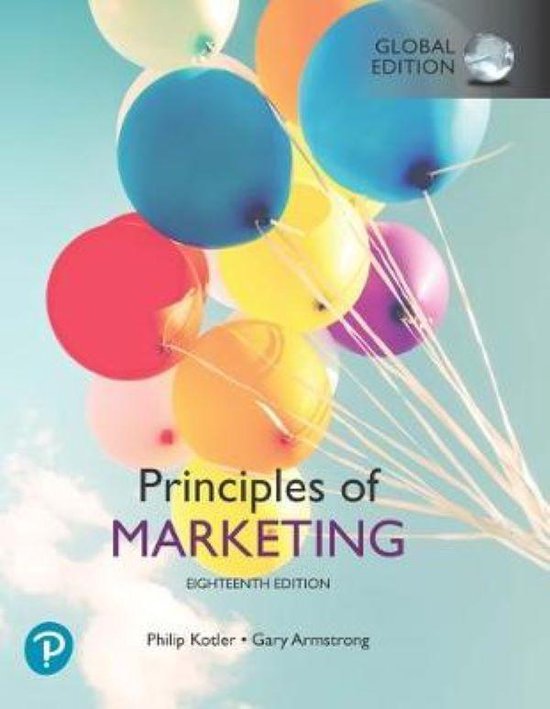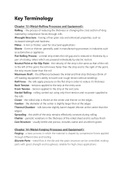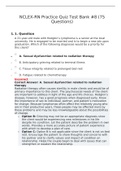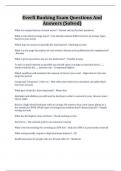EMIRATES’ CUSTOMER VALUE-DRIVEN MARKETING: ENGAGING CUSTOMERS AND
BUILDING A BRAND COMMUNITY
Emirates sought to ensure that it would not only provide high-quality service but also be innovative, modern,
and customer-oriented.
The airline has pursued a customer-focused value proposition through a combination of products, services
and experienced.
The Skywards Program (loyalty program) is an important part of Emirates’ success in building strong customer
relationships.
‘’Emirates is not just offering a way to connect people from point A to point B but aims to be the catalyst to
connect people’s dreams, hopes and aspirations’’.
WHAT IS MARKETING?
Marketing = engaging customers and managing profitable customer relationships.
Goal: attract new customers by promising superior value and to keep and grow current customers
by delivering value and satisfaction.
Marketing defined
Marketing needs to be understood in the sense of satisfying customer needs. If the marketer engages
consumers effectively, understand their needs, develops products that provide superior customer value, and
prices, distributes and promotes them well, these products will sell easily.
Marketing = the process by which companies engage customers, build strong customer relationships and
create customer value in order to capture value from customers in return.
The Marketing Process
Five-step model of the marketing process for creating and capturing customer value:
So: By creating value for consumers, they in turn capture value from consumers in the form of sales, profits,
and long-term customer equity.
UNDERSTANDING THE MARKETPLACE AND CUSTOMER NEEDS
This is the first step in the five-step model: we need to understand customer needs and wants and the
marketplace in which they operate. We examine five core customer and marketplace concepts:
1 - Customer Needs, Wants and Demands
Needs = states of felt deprivation. Marketers don’t create these needs, they are a basic part of the human
makeup.
Wants = the form human needs take as they are shaped by culture and individual personality. They are
shaped by one’s society and are described in terms of objects that will satisfy those needs.
Demands = human wants that are backed by buying power.
1
,In order to learn and understand customer needs, marketers are going to great lengths. They conduct
customer research, analysis of customer data etc.
2 – Market Offerings; Products, Services and Experiences
Needs and wants are fulfilled through market offerings (= some combination of products, services, information,
or experiences offered to a market to satisfy a need or want)
Market myopia = the mistake of paying more attention to the specific products a company offers than to the
benefits and experiences produced by these products.
Smart marketers look beyond the attributes of the products and services they sell creating brand
experiences for consumers.
Example Walt Disney World Resort: they don’t offer just amusement park rides, it uses its famed
Disney magic to create carefully orchestrated guest experiences that make dreams come true. See
Real Marketing 1.1, p.28.
3 – Customer Value and Satisfaction
Customers form expectations about the value and satisfaction that various market offerings will deliver and
buy accordingly. Satisfied customers will buy again and tell others about their own experience, dissatisfied
customers switch to competitors and disparage the product to others.
4 – Exchanges and Relationships
Exchange = the act of obtaining a desired object from someone by offering something in return. In a broad
sense, a marketer tries to bring about a response to some market offering.
Marketing consists of actions taken to create, maintain, and grow desirable exchange relationships with target
audiences involving a product, service, idea or other object. Building strong relationships by consistently
delivering superior customer value.
5 – Markets
Market = the set of all actual and potential buyers of a product or service. These buyers share a particular
need or want that can be satisfied through exchange relationships.
Marketing means managing markets to bring about profitable customer relationships.
Figure 1.2, p.30 shows a Modern Marketing System:
Each party in the system adds value for the next level. A company’s success at engaging customers and building
profitable relationships depends not only on its own actions but also on how well the entire system serves the
needs of the final customers.
DESIGNING A CUSTOMER VALUE-DRIVEN MARKETING STRATEGY AND PLAN
Marketing management = the art and science of choosing target markets and building profitable relationships
with them.
2
,The marketing manager must answer two important questions:
What customers will we serve (= what is our target market?)
o Market segmentation: dividing the market into segments of customers;
o Target marketing: selecting which segments it will go after.
Ultimately, marketing managers must decide which customers they want to target and the level,
timing, and nature of their demand.
How can we serve these customers best? (= what is our value proposition?)
o How are we going to differentiate and position ourself in the marketplace?
o Value proposition = the set of benefits or values it promises to deliver to customers to satisfy
their needs. Why should a customer buy your brand rather than a competitor’s?
There are five alternative concepts under which organizations design and carry out marketing strategies:
1 – The Production Concept
= the idea that consumers will favor products that are available and highly affordable; therefore, the
organization should focus on improving production and distribution efficiency.
This is one of the oldest concepts that guide sellers.
2 – The Product Concept
= The idea that consumers will favor products that offer the most quality, performance and features; therefore,
the organization should devote its energy to making continuous product improvements.
Note: only focusing on the company’s products could lead to marketing myopia.
3 – The Selling Concept
= The idea that consumers will not buy enough of the firm’s products unless the firm undertakes a large-scale
selling and promotion effort.
This is typically practices in unsought goods, such as life insurance or blood donation.
4 – The Marketing Concept
= A philosophy in which achieving organizational goals depends on knowing the needs and wants of target
markets and delivering the desired satisfactions better than competitors do.
In this concept, customer focus and value are the paths to sales and profits. Finding the right products for
your customers.
Figure 1.3, p.32 shows the contrast between the selling (inside-out perspective) and marketing
concepts (outside-in perspective).
5 – The Societal Marketing Concept
= the idea that a company’s marketing decisions should consider consumers’ wants, the company’s
requirements, consumers’ long-run interests, and society’s long-run interests.
Many leading business and marketing thinkers are preaching the concept of shared value (societal and
economic needs both).
Figure 1.4, p.33 shows three considerations underlying the societal marketing concept: company
profits, consumer wants and society’s interests.
After outlining which customers the marketing strategy will serve and how it will create value for these
customers, the marketer develops an integrated marketing program that will deliver the intended value to
target customers.
= Marketing mix: 4P’s (product, price, place, promotion).
MANAGING CUSTOMER RELATIONSHIPS AND CAPTURING CUSTOMER VALUE
This is the fourth and most important step in the marketing process: engaging customers and managing
profitable customer relationships.
Customer relationship management = the most important concept of modern marketing. It is the overall
process of building and maintaining profitable customer relationships by delivering superior customer value
and satisfaction.
3
, The key to building lasting customer relationships is to create superior customer value and satisfaction. A
customer buys from the firm that offers the highest customer-perceived value (=the customer’s evaluation of
the difference between all the benefits and all the costs of a market offers relative to those of competing
offers)
Customer satisfaction = the extent to which a product’s perceived performance matches a buyer’s
expectations.
A higher level of customer satisfaction leads to greater customer loyalty, which in turn results in better
company performance.
Beyond offering consistently high value and satisfaction, marketers can use specific marketing tools to develop
stronger bonds with customers.
Today’s companies are using online, mobile, and social media to refine their targeting and to engage
customers more deeply and interactively.
Customer engagement marketing = making the brand a meaningful part of consumers’ conversations and lives
by fostering direct and continuous customer involvement in shaping brand conversations, experiences and
community.
Goal is to make a brand a meaningful part of consumers’ conversations and lives.
Successful engagement marketing means making relevant and genuine contributions to targeted
consumers’ lives and interactions.
Customer brand advocacy = actions by which satisfied customers initiate favorable interactions with others
about a brand.
One form of customer-engagement marketing is consumer-generated marketing (=brand exchanges created
by consumers themselves – both invited and uninvited – by which consumers are playing an increasing role in
shaping their own brand experiences and those of other consumers). Example: #MyOreoCreation.
Marketers must work closely with a variety of marketing partners; they must be good at partner relationship
management (=working closely with partners in other company departments and outside the company to
jointly bring greater value to customers).
They must partner with suppliers, channel partners, and others outside the company.
The fifth step in the marketing process involves capturing value, the firm creates satisfied customers who stay
loyal, buy more and advocate the brand to others.
Customer lifetime value = the value of the entire stream of purchases a customer makes over a lifetime of
patronage. Companies must aim high in building customer relationships.
Beyond retaining good customers to capture customer lifetime value, good customer relationship management
can help marketers to increase their share of customers (=the portion of the customer’s purchasing that a
company gets in its product categories).
To increase the share of customers, firms can offer greater variety to current customers.
Customer equity = the total combined customer lifetime values of all of the company’s customers.
Creating high customer equity is the ultimate aim of customer relationship management.
The company can classify customers according to their potential profitability and manage its relationships with
them accordingly see figure 1.5, p.41.
Strangers: low potential in profitability and little projected loyalty
o Don’t invest in them, make money on every transaction.
Butterflies: potentially profitable, but not loyal.
o Create satisfying and profitable transactions, cease investing when they are gone after a short
time.
True friends: both profitable and loyal.
o Make continuous relationship investments to delight these customers.
4












